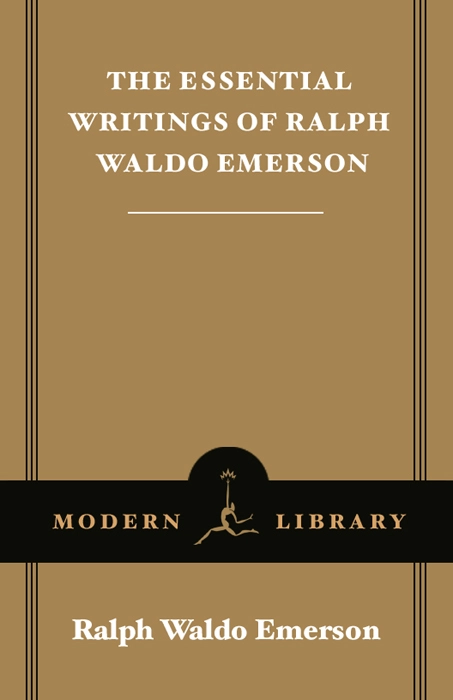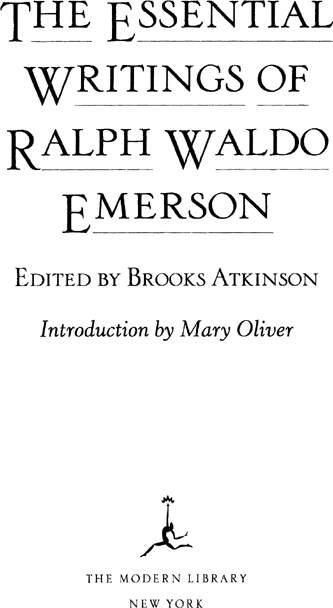The Essential Writings of Ralph Waldo Emerson


RALPH WALDO EMERSON
Ralph Waldo Emerson was born on May 25, 1803, in Boston, Massachusetts. At Harvard he won prizes for his oratory and essays. He studied briefly at Harvard Divinity School but was forced to interrupt his courses because of eye trouble. In 1826 he began a career as a minister, eventually becoming junior pastor of the Second Church of Boston. He married Ellen Tucker in 1829, despite the fact that she was already ill with tuberculosis; she died two years later at the age of nineteen.
After the death of his wife, Emerson went to Europe, where he met Landor, Mill, Coleridge, Wordsworth, Carlyle, and others. On his return he settled in Concord, Massachusetts, and a year later married Lydia Jackson. What would eventually be called the Transcendental Club had begun to form around him, its members including Margaret Fuller, Bronson Alcott, and Orestes Brownson. The spiritual ferment of the Concord group found expression in Emerson’s first significant work, the essay “Nature” (1836), in which he sketched the ideas that his later writings were to elaborate: “The use of natural history is to give us aid in supernatural history: the use of the outer creation, to give us language for the beings and changes of the inward creation…. By degrees we may come to know the primitive sense of the permanent objects of nature, so that the world shall be to us an open book, and every form significant of its hidden life and final cause.” This was followed by two profoundly influential orations, “The American Scholar,” a powerful statement of individualism, and “The Harvard Divinity School Address,” whose unorthodox religious views created a scandal: “Historical Christianity has fallen into the error that corrupts all attempts to communicate religion…. It has dwelt, it dwells, with noxious exaggeration about the person of Jesus. The soul knows no persons.”
Around this time Emerson became closely associated with Henry David Thoreau and with the mystical poet Jones Very. He gave up preaching and collaborated with Margaret Fuller on the journal The Dial, in which he began to publish his essays. These appeared in book form as Essays: First Series (1841) and Essays: Second Series (1844). He became more involved in political issues, launching attacks on the Mexican War and slavery His essays had made him an internationally known figure, and on a return trip to Europe in 1847 he met with a wide range of writers and thinkers, including Dickens, Tocqueville, and Tennyson. He published further collections of his essays and public addresses—Nature, Addresses, and Lectures (1849), Representative Men (1850), English Traits (1856), The Conduct of Life (1860)—while lecturing against slavery throughout the Northeast. Whitman’s Leaves of Grass elicited an enthusiastic response from him, although he attempted to persuade the poet to tone down the poem’s sexual imagery
Following the Civil War, Emerson continued to lecture energetically, publishing Society and Solitude (1870) and the verse collection May-Day and Other Pieces (1867). In 1872 his health began to fail, and after a final trip to Europe he settled into a quieter routine as his memory gradually weakened. He died in Concord, of pneumonia, on April 27, 1882.
CONTENTS
Introduction by Mary Oliver
NATURE
THE AMERICAN SCHOLAR
AN ADDRESS
THE TRANSCENDENTALIST
THE LORD’S SUPPER
ESSAYS: FIRST SERIES
History
Self-Reliance
Compensation
Spiritual Laws
Love
Friendship
Prudence
Heroism
The Over-Soul
Circles
Intellect
Art
ESSAYS: SECOND SERIES
The Poet
Experience
Character
Manners
Gifts
Nature
Politics
Nominalist and Realist
New England Reformers
PLATO; OR, THE PHILOSOPHER
NAPOLEON; OR, THE MAN OF THE WORLD
ENGLISH TRAITS
I. First Visit to England
II. Voyage to England
III. Land
IV. Race
V. Ability
VI. Manners
VII. Truth
VIII. Character
IX. Cockayne
X. Wealth
XI. Aristocracy
XII. Universities
XIII.
1 comment